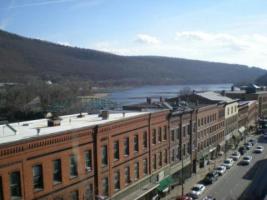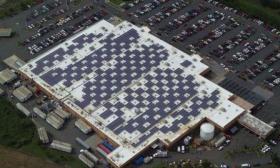
Municipalities and public agencies across America (and elsewhere) are investing in renewable energy generation to offset some of the costs of purchased energy. A penny saved, is a penny earned, and we’re not talking about pennies! At times, these efforts result in surplus energy, for which there’s always a market. Funds thus generated can significantly defray taxes.
Brattleboro has significant opportunities to benefit from renewable power. In fact, we have already embarked upon this path.
From the ReformerFriday March 29, 2013:
BRATTLEBORO — The Brattleboro Town School Board has agreed to take part in a community solar project that will provide renewable solar energy for all of the district’s buildings.
Green Street, Oak Grove and Academy schools will all be served by the agreement, which could save the district up to $13,000 annually.
The school board signed a solar net metering credit purchase agreement with Southern Vermont Renewable Energy, or Soveren, a Westminster-based solar installation company.
Soveren is developing the 500-kw solar farm in Westminster with the help of third party financing.
The school district will not invest any money in the development of the solar farm.
From iBrattleboro December 03 2012
Solar Farm Proposed For Brattleboro (Contributed by: Lise)
The Town Energy Committee has proposed that the Town spearhead the development of a 500 kilowatt solar energy farm here in Brattleboro. At tomorrow’s Selectboard meeting, the board will consider the Committee’s request to authorize Town Manager Barbara Sondag to draft an RFP to solicit proposals on the project. According to the Committee’s November 14 memo to the board, the project would not be financed by the Town but by the chosen developer. Moreover, the Town would be given a fixed, below-market preferential rate on energy purchases for the 20 year life of the project.
And again, from the Reformer 04/02/2014 – this one’s a biggie: Bill allows major solar project at former Bratt landfill
BRATTLEBORO — While Vermont’s newly expanded net-metering law encourages more small-scale solar development statewide, it also opens a specific — and very large — door for Windham County.
About halfway through the legislation, there is language declaring that “as a pilot project, the Public Service Board shall allow one solar facility or a group of solar facilities to be installed by one or more municipalities on a closed landfill in Windham County and treated as a net-metering system.” The law, which was signed by Gov. Peter Shumlin on Tuesday, also allows such a solar facility to generate up to 5 megawatts of power — far exceeding the standard 500-kilowatt ceiling for net-metered projects. http://www.reformer.com/localnews/ci_25471373/bill-allows-major-solar-project-at-former-bratt5 Megawatts is a considerable array!
Also happening in Brattleboro:
REC Solar, a national leader in solar electric system design and installation, and Integrated Solar, a Vermont renewable energy company, today announced they have been selected to build a 2.5-megawatt DC solar array in Brattleboro, Vermont. The system will be owned and operated by Winstanley Enterprises, a New England property owner. The project is a key part of Vermont’s initiative to reach 55 percent renewable energy by 2017. http://www.esolarenergynews.com/2013/12/rec-solar-and-integrated-solar-selected.html
I believe Green Mountain Power has agreed to purchase 100% of the power generated by this project which is expected to be on line this year.
Putney is getting in on the act, too:
From Brattleboro Reformer. September 8, 2013.
PUTNEY — The Selectboard has chosen Integrated Solar to build a new solar array that will provide all of the electricity needs for the town’s buildings. – See more at: http://energizevermont.org/2013/09/brattleboro-reformer-putney-approves-townwide-solar-project/#sthash.7oiVle15.dpuf
There’s more…quite a bit more!
As can be seen from the picture at the beginning of this piece, Brattleboro has a lot of flat roofs. Ideal for solar. These sites can be developed piecemeal by the individual landowners, or a coordinated effort can be sponsored by the town to help make it happen.
Here’s a photo of a Wal-Mart store solar roof:
 Besides solar, there’s wind, hydro, biomass and geothermal. There’s also energy storage. (even the abandoned Chestnut Hill reservoir has potential as a pumped-storage site).
Besides solar, there’s wind, hydro, biomass and geothermal. There’s also energy storage. (even the abandoned Chestnut Hill reservoir has potential as a pumped-storage site).
Brattleboro itself doesn’t have much potential for wind, hydro and geothermal. However, recent developments in legislation, finance, and electric utility practices allow participation in power generated elsewhere. Electrons are fungible – they don’t care where they come from.
And then there’s biomass! (From trees, purpose grown crops such as hemp , willow, industrial and municipal waste).
Municipal solid waste contains a lot of organic matter—about 65% according to U.S. Environmental Protection Agency, including paper (35.2%), food waste (11.7%), yard trimmings (12.1%), and wood (5.8%). This organic matter, when we dump it somewhere, gradually breaks down due to action of bacteria. If the material is aerated (as in a compost pile), oxygen-loving (aerobic) bacteria will decompose it, producing water vapor and carbon dioxide. But if oxygen is not present (as is the case in landfills), “anaerobic” bacteria decompose the organic matter producing methane, carbon dioxide, water vapor, and trace compounds like hydrogen sulfide. (These gases account for the unpleasant odor coming from dumps.) The methane component of the landfill gas (about 50%) has significant energy content that can be captured.
In fact, people in Brattleboro have been doing exactly that for decades. Here’s a picture of two generators on Old Ferry Road: 
Windham and Cheshire counties are blessed with harvestable timber, and also with the facilities to turn the highest grades of this timber into marketable products. The remaining wood is an ideal biomass fuel. However, just as burning atoms to boil water is a poor way to generate electricity, so is burning wood – it’s. well, so nineteenth century – and “dirty” as well.
Modern technology uses gasification: essentially distilling the wood in an oxygen starved environment (pyrolysis), scrubbing the effluent gases and using them to power large internal combustion engines such as those used in ships and locomotives.
If the surplus generated heat is captured, it can be used for buildings (air-conditioning as well).
A byproduct is pure carbon biochar. Some of this can be used to fuel the pyrolization. The remainder has a market as a soil conditioner.
(There is current research in using carbon in the form of graphene to produce supercapacitors for energy storage in electrical vehicles).
At the end of the Representative Town Meeting, George Harvey began proposing that Brattleboro create a task force to examine just this sort of thing. Unfortunately, too many of the members had managed to filter out and a quorum no longer existed, so we could not discuss these ideas.
They’re still good ideas, and George isn’t going away. Expect more on this in the coming weeks.



Thanks
Thanks for taking the time to write up this exciting idea.
Good long range plan
It seems like a smart path to explore. The Selectboard wasn’t interested in setting up a new committee to look into this, but did charge George Harvey with starting a sub-committee of the Energy Committee to begin exploring options.
Not only would it do all the above, but also might help retain people in the area who know about power generation.
Many projects in the “olden days” were financed by subscription. I need to look more into it, but it seemed like a way for private individuals to invest in public projects, somewhat like stock shares.
One would think that some of the VY closing funds could be wisely spent in this area.
I too support renewable energy
As well as viable economic development strategies.
Thank you for putting time into this and I look forward to updates.
hub a plus?
Could Brattleboro use its hub status to create a regional energy project? Perhaps co-ordinating a number of smaller local projects? I’m thinking of distribution, providing a market for wood waste, etc. We’ve heard a lot about Bratt’s carrying the tax burden for services used by surrounding towns; maybe the town’s central status could be used to offset those costs as well.
local economics
Brattleboro is exporting $24 million each year to buy electricity. By generating its own electricity, we can keep that money local, creating jobs, reducing taxes. Local, renewable power is already the least expensive to buy – less expensive than nuclear, gas, or hydro.
We could go beyond that. If we eventually generate double the electricity we now use, the rest could be used to supply heat for the town, its people, and its businesses. This could keep another $25 million or more in the economy, creating more jobs and reducing taxes more. Since heat pumps are less expensive to run than burning cordwood, that would reduce our heating bills.
count me in
I’ve liked this plan ever since it was first brought up in public.
I’m not sure of the total, but we also send a lot of our local money away to internet and cable providers. This, too, can be a local service and provide similar benefits – great jobs, keeping money local, and lower costs.
We know what to do. How do we get it done?